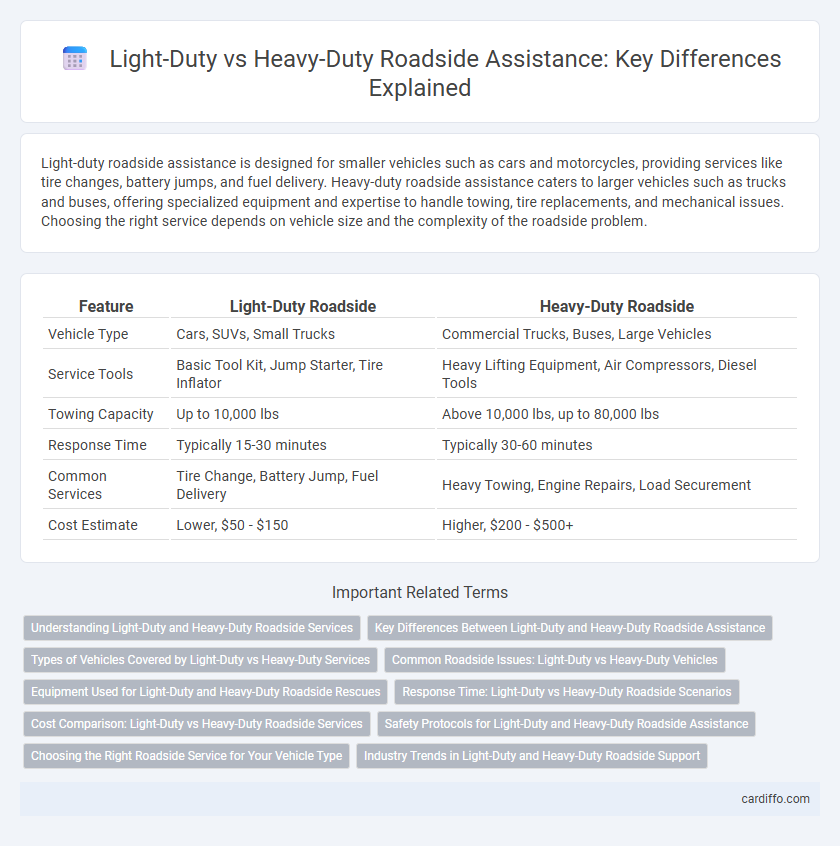Light-duty roadside assistance is designed for smaller vehicles such as cars and motorcycles, providing services like tire changes, battery jumps, and fuel delivery. Heavy-duty roadside assistance caters to larger vehicles such as trucks and buses, offering specialized equipment and expertise to handle towing, tire replacements, and mechanical issues. Choosing the right service depends on vehicle size and the complexity of the roadside problem.
Table of Comparison
| Feature | Light-Duty Roadside | Heavy-Duty Roadside |
|---|---|---|
| Vehicle Type | Cars, SUVs, Small Trucks | Commercial Trucks, Buses, Large Vehicles |
| Service Tools | Basic Tool Kit, Jump Starter, Tire Inflator | Heavy Lifting Equipment, Air Compressors, Diesel Tools |
| Towing Capacity | Up to 10,000 lbs | Above 10,000 lbs, up to 80,000 lbs |
| Response Time | Typically 15-30 minutes | Typically 30-60 minutes |
| Common Services | Tire Change, Battery Jump, Fuel Delivery | Heavy Towing, Engine Repairs, Load Securement |
| Cost Estimate | Lower, $50 - $150 | Higher, $200 - $500+ |
Understanding Light-Duty and Heavy-Duty Roadside Services
Light-duty roadside services typically cater to smaller vehicles such as passenger cars and SUVs, offering assistance like tire changes, jump-starts, and fuel delivery. Heavy-duty roadside services are specialized for large commercial trucks and buses, providing complex support including towing, tire repair, and mechanical diagnostics on-site. Distinguishing between these service types ensures proper equipment and expertise are deployed for efficient roadside assistance.
Key Differences Between Light-Duty and Heavy-Duty Roadside Assistance
Light-duty roadside assistance primarily targets smaller vehicles such as cars and motorcycles, offering services like tire changes, battery jumps, and fuel delivery, while heavy-duty roadside assistance caters to larger commercial vehicles including trucks and buses, providing more extensive support such as towing for heavy loads and hydraulic lifting. Service equipment for heavy-duty roadside assistance is engineered to handle greater weight and size, requiring specialized tools and trained technicians capable of managing complex mechanical issues. Response times and service scope also differ, with heavy-duty assistance often involving longer durations due to the complexity and size of the vehicles involved.
Types of Vehicles Covered by Light-Duty vs Heavy-Duty Services
Light-duty roadside services primarily cover passenger vehicles, including cars, SUVs, pickup trucks, and small vans, which typically weigh under 10,000 pounds. Heavy-duty roadside services cater to larger commercial vehicles such as buses, semi-trucks, large cargo trucks, and construction equipment, which exceed this weight threshold. Service requirements differ significantly due to the size, weight, and complexity of the vehicles involved.
Common Roadside Issues: Light-Duty vs Heavy-Duty Vehicles
Light-duty vehicles commonly encounter roadside issues such as tire punctures, battery failures, and engine overheating, often due to everyday wear and tear. Heavy-duty vehicles face more complex problems including brake system failures, transmission malfunctions, and load-related tire blowouts, which are exacerbated by heavy cargo and prolonged operational stress. Preventative maintenance and specialized roadside assistance are crucial for both vehicle types to minimize downtime and ensure safety.
Equipment Used for Light-Duty and Heavy-Duty Roadside Rescues
Light-duty roadside rescues typically utilize portable tools such as hydraulic jacks, battery-powered impact wrenches, and compact winches designed for smaller vehicles like sedans and motorcycles. Heavy-duty roadside equipment includes industrial-grade hydraulic rescue tools, heavy winches with high tensile strength, and large air compressors to manage the extrication and recovery of trucks, buses, and other heavy vehicles. The choice of equipment reflects the vehicle size, weight capacity, and complexity of the rescue operation.
Response Time: Light-Duty vs Heavy-Duty Roadside Scenarios
Light-duty roadside assistance typically features faster response times, averaging 20 to 30 minutes, due to the smaller, more agile service vehicles and less complex repair requirements. Heavy-duty roadside response often ranges from 45 minutes to over an hour because of the need for specialized equipment and personnel to handle larger vehicles like trucks and buses. Efficient dispatch systems and strategic location of service units are critical in minimizing delays across both light-duty and heavy-duty roadside scenarios.
Cost Comparison: Light-Duty vs Heavy-Duty Roadside Services
Light-duty roadside services, such as tire changes and jump-starts, typically cost between $50 and $150, offering quick and affordable assistance for minor vehicle issues. Heavy-duty roadside services, including towing and recovery for large trucks or commercial vehicles, range from $200 to $600 or more, reflecting the complexity and equipment required. The cost difference is primarily driven by vehicle size, service complexity, and specialized equipment needs.
Safety Protocols for Light-Duty and Heavy-Duty Roadside Assistance
Light-duty roadside assistance primarily involves smaller vehicles and emphasizes quick safety checks such as hazard light activation, reflective triangle placement, and safe vehicle positioning to protect drivers and responders. Heavy-duty roadside protocols require specialized equipment and trained personnel to manage larger vehicles like trucks and buses, focusing on securing the area with heavy-duty cones, utilizing wheel chocks, and coordinating with traffic management for complex towing operations. Both safety protocols aim to minimize accident risks and ensure efficient roadside repairs or recoveries under varying traffic and vehicle conditions.
Choosing the Right Roadside Service for Your Vehicle Type
Selecting the appropriate roadside service depends heavily on whether your vehicle is light-duty or heavy-duty, as each type requires specialized equipment and expertise. Light-duty roadside assistance typically covers cars, motorcycles, and small trucks, offering services like tire changes, jump-starts, and fuel delivery. Heavy-duty roadside services cater to larger vehicles such as commercial trucks and buses, providing advanced support including winching, heavy towing, and complex mechanical repairs.
Industry Trends in Light-Duty and Heavy-Duty Roadside Support
Industry trends in roadside support reveal a growing specialization between light-duty and heavy-duty services, driven by the increasing complexity of vehicle technology. Light-duty roadside assistance focuses on rapid, tech-savvy solutions for passenger cars and small trucks, incorporating mobile diagnostics and app-based service dispatch. Heavy-duty support emphasizes robust equipment and trained personnel to handle commercial trucks and large fleets, addressing regulatory compliance and minimizing downtime through preventive maintenance and advanced telematics.
Light-Duty vs Heavy-Duty Roadside Infographic

 cardiffo.com
cardiffo.com